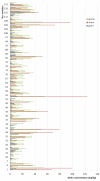Relationship of deoxynivalenol content in grain, chaff, and straw with Fusarium head blight severity in wheat varieties with various levels of resistance
- PMID: 25751146
- PMCID: PMC4379521
- DOI: 10.3390/toxins7030728
Relationship of deoxynivalenol content in grain, chaff, and straw with Fusarium head blight severity in wheat varieties with various levels of resistance
Abstract
A total of 122 wheat varieties obtained from the Nordic Genetic Resource Center were infected artificially with an aggressive Fusariumasiaticum strain in a field experiment. We calculated the severity of Fusarium head blight (FHB) and determined the deoxynivalenol (DON) content of wheat grain, straw and glumes. We found DON contamination levels to be highest in the glumes, intermediate in the straw, and lowest in the grain in most samples. The DON contamination levels did not increase consistently with increased FHB incidence. The DON levels in the wheat varieties with high FHB resistance were not necessarily low, and those in the wheat varieties with high FHB sensitivity were not necessarily high. We selected 50 wheat genotypes with reduced DON content for future research. This study will be helpful in breeding new wheat varieties with low levels of DON accumulation.
Figures



References
Publication types
MeSH terms
Substances
LinkOut - more resources
Full Text Sources
Other Literature Sources

